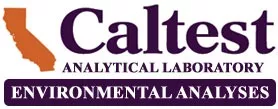
Pyrethroid Pesticide Analysis in Sediment, Stormwater, Surface Water and Wastewater
Click here to download Caltest’s Pyrethroids Information Sheet.
Background
Pyrethroid Pesticides have been associated with toxicity in urban and agricultural stream bed sediments (1,2,3,4). Investigations into whether pyrethroids were also found in the water column at concentrations that contribute to toxicity have generally been hampered by inadequate sensitivity of analytical methods (5). In 2008 and 2009 the State of California sponsored studies that indicated detectable concentrations of pyrethroids in water from urban stormwater runoff and POTW effluents (6,7) The analysis was performed with a Gas Chromatograph (GC) using a micro electron capture detector (μECD) and multiple extract cleanups. These detectable concentrations were correlated with toxicity to Hyalella azteca, a sediment toxicity test organism used in a test adapted to water toxicity testing. The State of California has narrative criteria for protection of waters essentially stating no toxics in toxic concentrations. Recent and current draft basin plan amendments for pesticide toxicity have been broadly written to include pyrethroids as well as other current use and future use pesticides.
Current Status of Monitoring
Sediments associated with pyrethroid contamination and associated toxicity are usually fine grained, from areas of deposition in creeks or stormwater channels. Reporting Limits for sediments should meet a threshold of reporting of 1μg/Kg (ng/g) dry weight to be relevant in interpreting toxicity test data.
More studies of urban run-off are showing high incidence of samples showing toxicity and detections of pyrethroids in the range of EC-50s (the Effect Concentration, where 50% of the test organisms are paralyzed or otherwise impaired, but not dead) and LC-50s (The Lethal Concentration where 50% of the test organisms die, common definition of Acute Toxicity). This has caused an increased interest in pollution prevention activities (see the Urban Pesticide Pollution Prevention aka UP3 website for lots of information http://www.up3project.org/).
Required Detection Limits are Lower
Ceriodaphnia has been the most common species for identifying toxicity in California waters. It is not particularly sensitive to pyrethroids and rarely indicates toxicity associated with pyrethroids. However the sediment testing organism Hyalella azteca is very sensitive to pyrethroids. This organism has been used in a water toxicology test and indicates toxicity in waters at very low levels in the range of 2 ng/L and up to 21 ng/L. The change of toxicity test organisms revealed toxicity at lower levels than previously reported, and thus drove the demand for analytical chemistry methods to provide even better sensitivity.
Starting in late 2008 as detection limits were pushed to around 0.5 to 3 ng/L, stormwater and urban run-off was found to be contaminated with pyrethroids, and correlated with toxicity using the most sensitive species. In 2009 the same finding was reported for three of three wastewater treatment plant effluents.
Analytical Methods
GC/ μECD
Most of the reported data for pyrethroids is by GC (Gas Chromatography) with a μECD (micro Electron Capture Detector). The GC/ECD approach relies on analysis by a second dis-similar column for confirmation of the identity of the analyte. This approach has been optimized by the use of extensive extract clean-ups to get MDLs (Method Detection Limit) and reporting limits in the 0.5 to 3 ng/L range by Lydy et.al. at Southern Illinois University. Up until 2008 or so, most labs doing low level pyrethroids analysis had reporting limits by GC/μECD in the range of 5-10 ng/L.
GCMS SIM with Electron Impact Ionization
Caltest has used this analytical approach to meet the sediment reporting limits of 1μg/Kg dry weight. While it is useful for sediment, in waters its MDLs in deionized waters are in the 4-7 ng/L range based on the standard 1000x concentration factors, and therefore too high for monitoring below toxicity levels.
GC/MS Ion Trap and GC/MS/MS Ion Trap
A federal research lab has published MDLs using the ion trap GC/MS at 2-6 ng/L. Using GC/MS/MS they report MDLs of 0.5-1.1 ng/L
GC/MS/MS with Electron Impact Ionization
Professor Jay Gan’s lab at UC Riverside has reported pyrethroids in stormwater at 0.5 ng/L. California Dept. of Fish and Game has presented similar capability using this technique.
GC/MS SIM with Negative Chemical Ionization (NCI)
The Pyrethroid Working Group submitted a method to the California Department of Pesticide Regulation using this technique (8). The method is that of Neil Robinson of Syngenta and written as a sediment technique. It was used to demonstrate excellent selectivity and sensitivity for pyrethroids in sediments. Per the method the limit of quantitation is 0.1 μg/Kg for bifenthrin, cypermethrin, cyfluthrin, deltamethrin, esfenvalerate, fenpropathrin, lambda cyhalothrin, and 1 μg/Kg for permethrin. It has since been adapted for water analyses. At Caltest deionized water MDL study results are 0.14-0.45 ng/L with permethrin 3.9-4.8 ng/L. Secondary POTW Effluent matrix specific MDLs using a 5,000x concentration factor were 0.38-1.3 ng/L.
Method Detection Limits (MDLs)
Not all analytical method papers use the same process to determine a Method Detection Limit. Not even the same terms are used. Some call the threshold of detection or reporting the Limit of Detection. Some who use the term MDL don’t use the same procedure to calculate, or the same rules to consider the calculated MDL valid. Some estimate the MDL based on the lowest standard with a signal to noise ratio of at least 3:1.
Caltest and those following EPA environmental method protocols use the MDL process defined in 40 CFR (Code of Federal Regulations) Part 136, Appendix B. This requires seven or more replicates of a spike at a level estimated to be 1-5x the expected calculated MDL, and no more than 10x the calculated MDL. If those ratios are not met, the MDL did not meet criteria and should be repeated. Following this procedure should yield a calculated concentration where the measurement has a 99% confidence that the number is greater than zero. Results above the MDL but below the lowest calibration standard are flagged as estimates of quantitation. Accuracy and precision generally improve to method criteria at 3-5x the MDL, sometimes up to 10x the calculated MDL. MDLs are generally higher in the environmental matrix than they are in test matrices in the lab which consist of deionized water for aqueous samples, and roasted sand or roasted sodium sulfate for sediments and soils methods. The matrix MDLs are higher because the matrix generally degrades the performance of the analytical system, and reduces precision. MDLs are lower where the extract replicates have greater precision. If the matrix causes reduced precision (more variability in measuring the same spike concentration) then the resulting MDL will be higher.
Reporting Limit
Some refer to the reporting limit as a Minimum Level (ML), or a Level of Quantitation (LOQ), and generally mean the level corresponding to the lowest calibration standard used that met criteria. When an EPA method uses the term ML, it refers to the equivalent concentration in the sample that is represented by the lowest calibration point of a valid calibration curve. At Caltest our reporting limit is no lower than our lowest calibration standard used that met criteria. At minimum, EPA style reporting limits are supported by a low calibration standard and at or above a properly conducted MDL study value. Confidence in the data is increased when the ML is at least 2-5x higher than the MDL. A common target for method development is to have a MDL 10x lower than the concentration of critical interest.
References
- Amweg, E.L., Weston, D.P., Ureda, N.M. Use and toxicity of pyrethroid pesticides in the Central Valley, California, USA. Environmental Toxicology and Chemistry, Vol. 24, No. 4, pp. 966–972, 2005
- Weston, D.P., You, J. and Lydy, M.J.. 2004. Distribution and toxicity of sediment-associated pesticides in agriculture-dominated water bodies of California’s Central Valley . Environmental Science and Technology 38:2752-2759.
- Amweg, E.L., Weston, D.P., You, J., Lydy, M.J.. 2006. Pyrethroid insecticides and sediment toxicity in urban creeks from California and Tennessee, USA. Environmental Science and Technology, 40: 1700-1706
- Holmes, R.W., Anderson B.S., Phillips B.M., Hunt J.W., Crane, D.B., Mekebri, A., Connor, V. Statewide Investigation of the Role of Pyrethroid Pesticides in Sediment Toxicity in California’s Urban Waterways. Environmental Science. Technol. 2008, 42, 7003-7009
- Werner I. and Oram J. 2008. Pyrethroid insecticides conceptual model. Sacramento (CA): Delta Regional Ecosystem Restoration Implementation Plan.
- Weston D.P., Holmes, R.W.,Lydy, M.J.. 2009. Residential runoff as a source of pyrethroid pesticides in urban creeks. Environmental Pollution. 157: 287-294.
- Weston, D.P., Lydy, M.J. Urban and Agricultural Sources of Pyrethroid Insecticides to the Sacramento-San Joaquin Delta of California. Environmental Science and Technology, 2010, 44 (5), pp 1833–1840
- Robinson, N.J. Residue analytical method for the determination of residues of bifenthrin, cypermethrin, cyfluthrin, deltamethrin, esfenvalerate, Fenpropathrin, lambda-cyhalothrin and permethrin in sediment. 2007. Submittal to California Department of Pesticide Regulation on behalf of the Pyrethroid Working Group.
